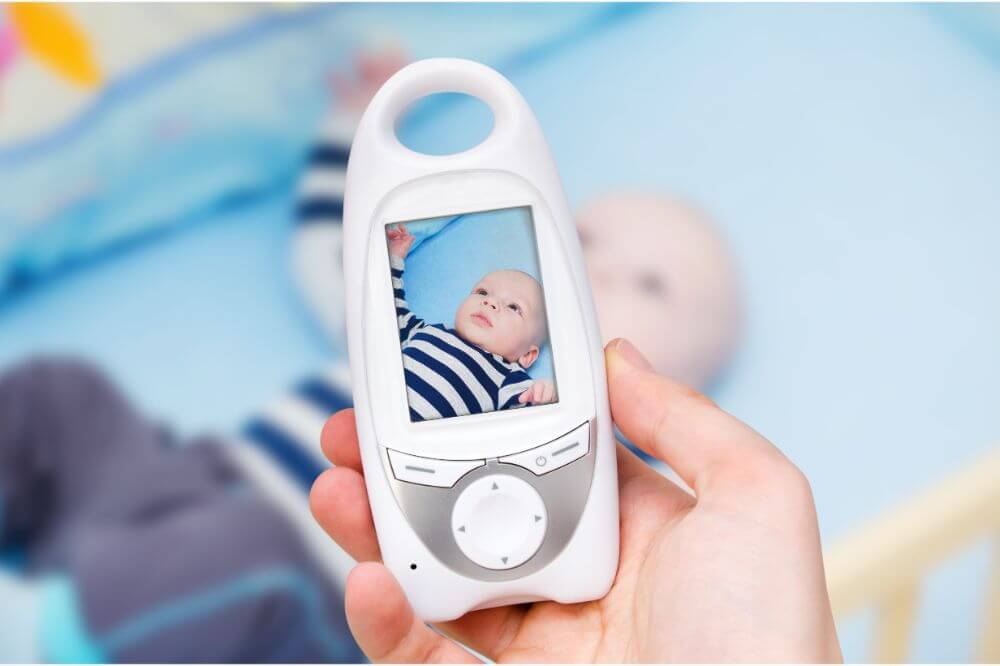When it comes to keeping track of your baby, baby monitors are a popular choice for many parents. Whether you’re looking for a basic audio monitor or a more advanced video monitor, there are a few things you should know about the radiation these devices may emit.
In this article, we’ll cover the types of baby monitors, if they emit radiation, and how to minimize any potential exposure.
Types of Baby Monitors
Radio Frequency (RF) baby monitors use radio waves to communicate between the monitor and the baby unit. They are the most common type of baby monitors and are typically the least expensive.
Wi-Fi baby monitors use internet technology to connect the monitor and the baby unit. They are more expensive than RF monitors but offer more features such as the ability to stream audio and video over the internet.
Video baby monitors feature a camera, display monitor, and microphone. The camera sends a live video feed of your baby to the display monitor and the microphone can be used to hear your baby.
Radio Frequency Baby Monitors
Radio Frequency baby monitors are the most common type of baby monitor. They use radio waves to transmit sound between the parent unit and the baby unit, and are relatively inexpensive.
The parent unit and the baby unit both have a transmitter and a receiver, and the sound is transmitted over a frequency of 49 MHz, 900 MHz, or 2.4 GHz.
These frequencies are within the microwave range, which is why they are considered a form of radiation. This type of baby monitor is not considered to be dangerous, however, as the radiation emitted is too weak to have any significant effect on humans.
Wi-Fi Baby Monitors
Wi-Fi baby monitors are the newest type of baby monitor on the market and are becoming increasingly popular due to their convenience and features.
Wi-Fi baby monitors usually come in the form of a camera connected to an app on your phone or computer. The camera connects to your home Wi-Fi network, and the app allows you to access the camera’s footage from anywhere with an internet connection.
As with radio frequency baby monitors, Wi-Fi baby monitors emit radio waves, but they use a different frequency than radio frequency monitors. Wi-Fi baby monitors also emit electromagnetic radiation, but at a much lower level than radio frequency monitors.
While the amount of radiation emitted by Wi-Fi baby monitors is much lower than radio frequency monitors, it is still important to be aware of the potential risks associated with this type of radiation.
Video Baby Monitors
Video baby monitors are an increasingly popular way for parents to keep an eye on their babies when they cannot be in the same room. These monitors work by sending a signal from the camera to the receiver, allowing parents to see and hear their babies in real-time.
The good news is that video baby monitors do not emit any radiation, so parents can have peace of mind knowing their babies are safe. While video baby monitors don’t emit radiation, they do require access to a power source, which means they can be susceptible to power surges or outages.
It’s important to read the instructions that come with any video baby monitor to ensure you’re using it correctly and safely.
Do Baby Monitors Emit Radiation?
Radio Frequency Baby Monitors emit radiation because they use radio waves. In order to reduce the amount of radiation, it is important to keep the device away from the baby and ensure that the antenna is not obstructed.
Wi-Fi Baby Monitors do not emit radiation since they use a wireless router, however the router can expose your child to other sources of radiation. Video Baby Monitors also do not emit radiation, as they rely on a wired connection to transmit the video signal.
Radio Frequency Baby Monitors
Radio frequency (RF) baby monitors are the most common type of baby monitor, and emit a very low frequency of radiation. This radiation is completely safe and is similar to the radiation emitted from cell phones and wireless internet networks.
The radiation is known as non-ionizing radiation and does not have enough energy to cause any damage to cells in the body. The radiation emitted by RF baby monitors is usually much less than the radiation emitted from cell phones and wireless internet networks. This is because the power output of RF baby monitors is much lower than that of cell phones and wireless internet networks.
Wi-Fi Baby Monitors
Wi-Fi baby monitors are becoming increasingly popular, but do they emit radiation? The short answer is yes, Wi-Fi baby monitors do emit radiation. This is because they emit electromagnetic fields (EMFs) as a result of the Wi-Fi connection.
These EMFs are in the 2.4GHz frequency, which is the same frequency as other Wi-Fi devices and microwave ovens. This type of EMF radiation is considered low-level, and while it is not considered to be harmful, it is still important to be aware of the potential risks.
It is also important to note that the strength of the EMFs emitted by Wi-Fi baby monitors is much lower than those emitted by cell phones and other devices.
The best way to minimize exposure to any type of EMF radiation is to keep the device at least three feet away from your baby, and to keep it turned off when not in use.

Video Baby Monitors
Video baby monitors, while not actually emitting radiation, are the most prone to radiation exposure. This is because they’re connected to a mobile device or computer, and the signal from the camera to the device can be affected by nearby radiation sources.
Wi-Fi routers and cell phones are two of the most common sources of radiation exposure that can interfere with a video baby monitor. To minimize exposure, it’s important to keep the monitor far away from sources of radiation, and also to make sure that it’s not connected to a device with a weak signal.
Additionally, manufacturers should take steps to ensure that their products are shielded from radiation.
How to Minimize Exposure to Radiation
It’s understandable to worry about the potential of radiation exposure when it comes to baby monitors. Fortunately, there are measures you can take to minimize your baby’s exposure.
First, make sure you buy a baby monitor that has been certified by a recognized testing organization, like Underwriters Laboratories (UL). These organizations test the product to make sure it meets safety standards.
When setting up your baby monitor, try to keep it at least three feet away from your baby. If it is a radio frequency monitor, keep it away from other electronic devices like your TV or stereo. This will help reduce interference and radiation levels.
You can also limit your baby’s exposure to Wi-Fi and video monitor radiation by keeping the device away from your baby’s cot. Additionally, choose a monitor that has a built-in low-radiation mode.
If you have any questions or concerns about the radiation levels of your baby monitor, talk to your pediatrician or contact the manufacturer. They can provide you with more information and help you make an informed decision.
Finally, make sure you follow the instructions for use provided by the manufacturer. Following the instructions will help ensure that your baby monitor is operating in a safe and secure manner.
Conclusion
It’s important to be aware of the potential risks associated with baby monitors, as any type of radiation can be harmful if exposed to it for too long. In addition to understanding the types of radiation emitted, it’s also important to take necessary steps to minimize any exposure.
The best way to ensure your baby is safe is to limit their exposure to any radiation emitted by the baby monitor. Make sure to keep the monitor away from your baby, turn the monitor off when it is not in use, and choose a model with lower radiation emissions.
When in doubt, it’s always best to consult with your healthcare provider before using any baby monitor.

